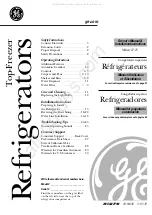
7
After a period of time frost will build up
in the ice compartment. As a temporary
measure, this frost should be scraped away
using a scraper.
Complete defrosting will however become necessary if the frost
This should be carried out if the frost build up cannot be scraped
away, or if it beginds to interfere with the food storage.
Proceed as follows:
1 T
urn the refrigerator off at the mains supply and leave the door open.
2
Scrape away as much frost build up as possible using a plastic scraper.
Thawing of the remainder can be speeded up by placing bowls of
hot water inside the refrigerator cabinet and closing the door. As the
solid frost loosens, prize it away with the plastic scraper and remove.
3
When defrosting is completed, clean you refrigerator as
described opposite.
SCRAPER NOT INCLUDED
CLEANING
Cleaning inside the refrigerator
You should clean the refrigerator internally with a weak solution of
bicarbonate of soda. Then rinse with warm water using a wrung-out
sponge or cloth. Wipe the refrigerator dry before replacing the food. Plug
in and switch on the mains supply.
Cleaning the outside of the refrigerator
Use standard furniture polish to clean the refrigerator exterior. Make
sure that the doors are closed, to prevent polish getting on the
magnetic door seal or inside. The grille of the condenser at the back of
the refrigerator and the adjacent components can be vacuumed using
a soft brush attachment.
Cleaning tips
Defrost and clean when food stocks are low.
NOTE Don’t use a metal or sharp instrument and do not use any
electrical appliances to aid defrosting.
Where to store your foods in
the refrigerator
Cool area
This is where to store foods which will keep longer if they are kept cool.
Milk, yogurt, fruit juices, hard cheeses eg, cheddar. Opened jars and
bottles of salad dressings, sauces and jams. Fats, eg. butter, margarine,
low-fat spreads, eggs, cooking fats and lard.
Coldest area: 1°C to 5°C
This is where foods which must be cold to keep them safe should be kept.
â
Raw and uncooked foods should always be wrapped.
â
Pre-cooked chilled foods, eg. ready meals, meat pies, soft cheeses.
â
Pre-cooked meats eg. ham.
â
Prepared salads (including pre-washed chopped, pre-packed mixed
green salads, rice, potato salad etc).
â
Desserts, eg. fromage frais, home-prepared food and leftovers or
cream cakes.
Salad bin
This is the most humid part of the refrigerator. Vegetables, fruit, fresh
salad items eg. unwashed whole lettuce, whole tomatoes, radishes etc.
WE RECOMMEND
THAT
ALL PRODUCE
KEPT
IN THE SALAD BIN
IS WRAPPED.
COOL
COOL
COLDEST
ICE COMPARTMENT
SALAD BIN
DEFROSTING
NOTE:
Always wrap and store raw meat, poultry and fish on the
lowest shelf at the bottom of the refridgerator. This will stop them
dripping onto, or touching other foods. Do not store inflammable
gases or liquids.
Summary of Contents for MUR49100
Page 1: ...How to use your new Refrigerator Model MUR49100...
Page 2: ......
Page 9: ......
Page 11: ...NOTES 11...
Page 12: ......






























